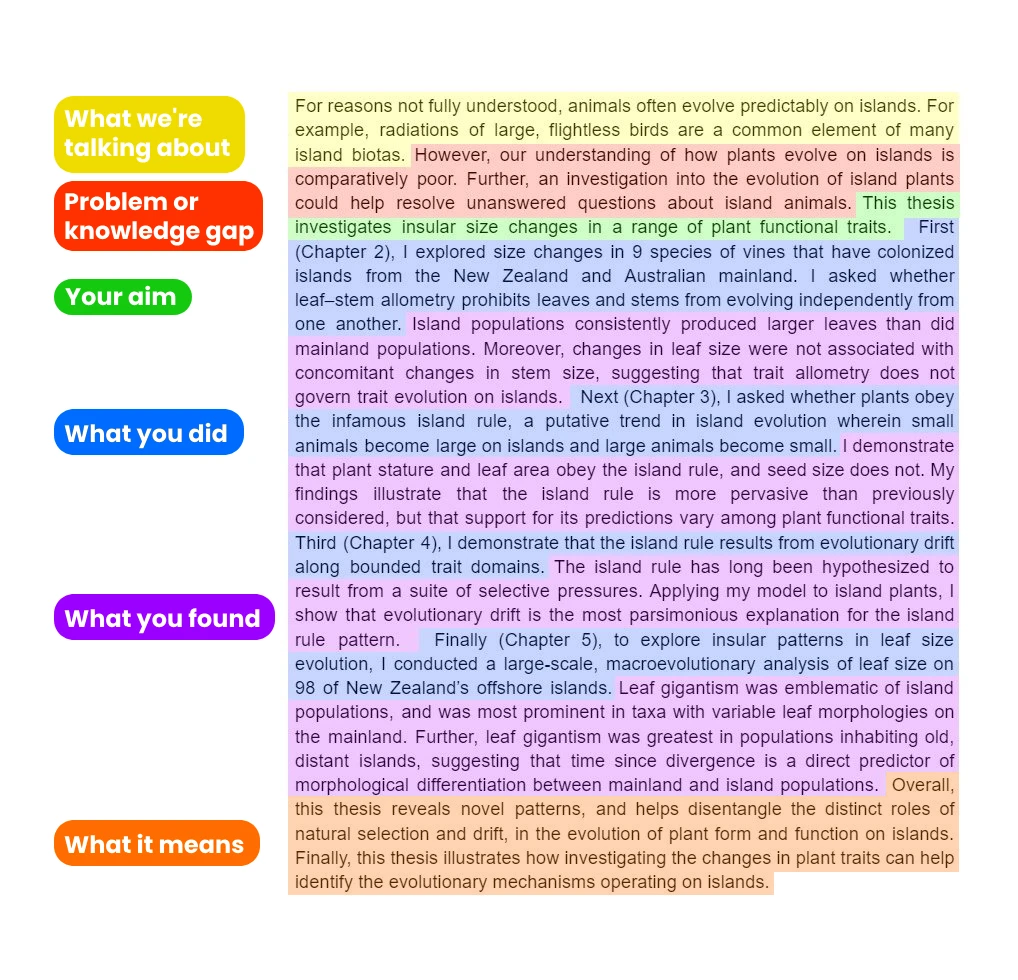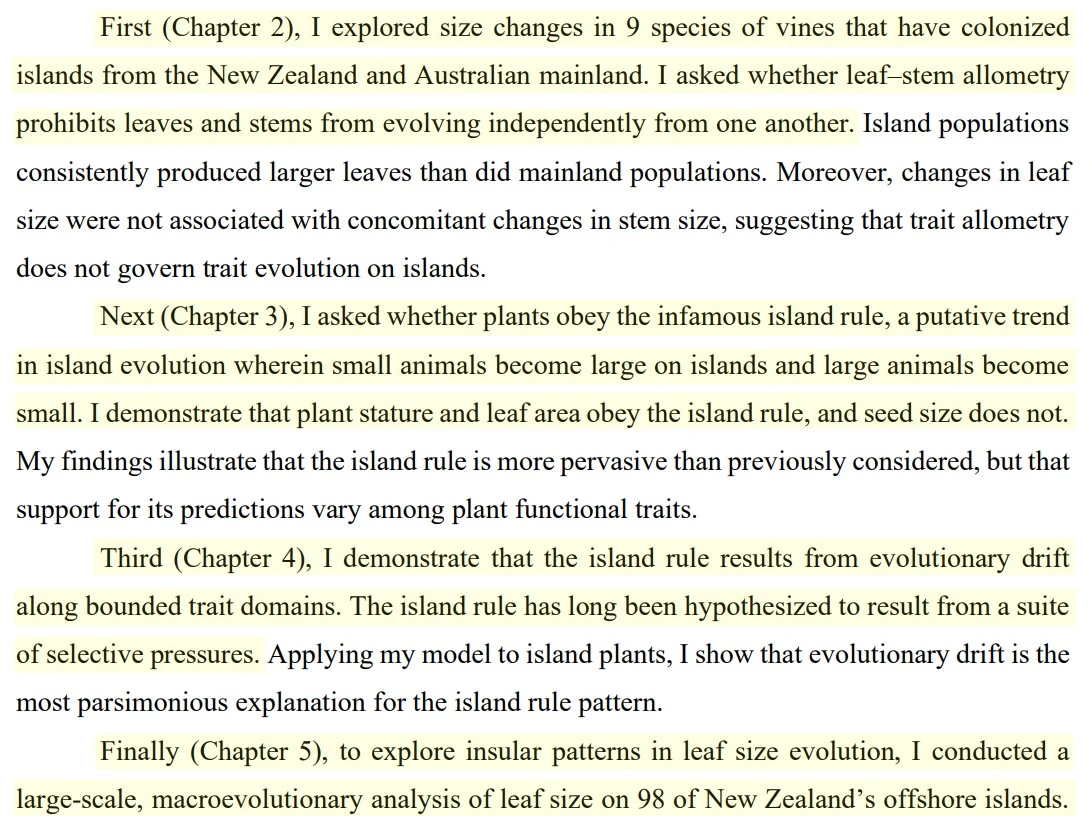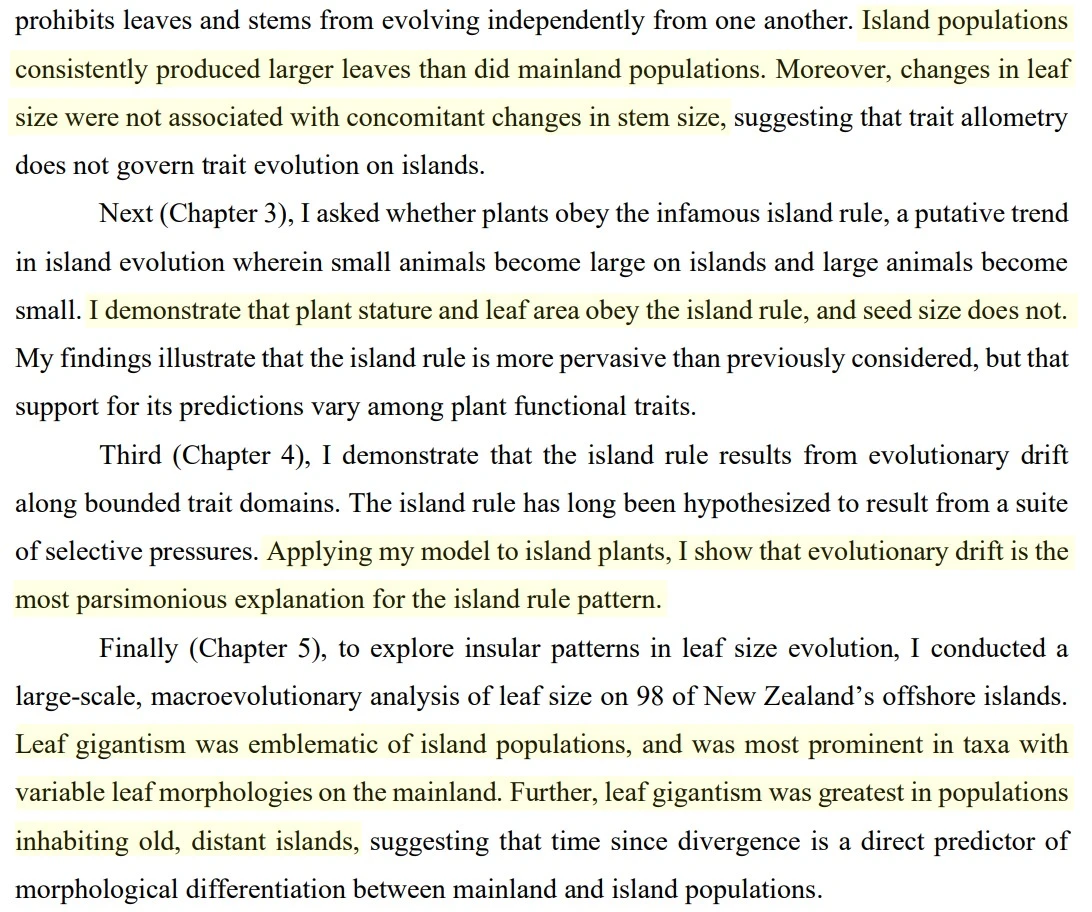Blog • Posted on Oct 9, 2024
How to Write a Thesis Abstract Worthy of the Dean’s List
Writing a thesis abstract can feel like an impossible task. How are you supposed to summarise years of work into a few hundred words?
While the key elements of a great thesis abstract echo those of a great research paper abstract, there are some crucial differences you need to know.
In this article, you’ll learn how to write a thesis abstract using a template and actionable strategy that helped me make the Dean’s List for an exceptional doctoral thesis.
To help illustrate this strategy, I’ve included examples from my own doctoral thesis. You can download my thesis abstract to use as a guide here.
Key Takeaways
- A thesis abstract is a concise summary of your entire thesis. It presents all core elements of your work
- Thesis abstracts and research paper abstracts share the same structure, being composed of a hook, a problem statement (or knowledge gap), a description of the methods used, important results and their implications.
- Your thesis abstract should follow the same logical order as your thesis. So, provide 1-2 sentences for each chapter.
- Keep any unnecessary information out of your thesis to avoid confusing the reader and diluting from the central storyline.
Table of Contents

What is a thesis abstract?
A thesis abstract is a concise summary of your thesis that gives readers an overview of the overarching research question, methods, findings, and implications.
It is a snapshot of the whole thesis and is typically the first section a reader encounters.
University guidelines vary, however thesis abstracts are usually limited to 250-300 words.
Though brief, a well-crafted thesis abstract provides enough detail for readers to grasp the overall purpose and significance of the research.
It serves as both a preview and an invitation for further reading.

See How We Can Help You Publish High Impact Easier Than Ever
- Mentoring - real meetings. Real results.
- Professional Editing - our team of former journal editors will get your manuscript publication-ready.
- Online Courses - learn invaluable presenting & writing skills.
Key similarities between research paper and thesis abstracts
Before diving into the differences, let’s look at how research paper abstracts and thesis abstracts share a common structure. Both types of abstracts should contain the following core components:
- Introduction/Background: Both types of abstracts start by framing the research context. This section explains the relevance and importance of the topic. It usually answers why the research was undertaken and offers a brief description of the problem being addressed.
- Research Aim/Objective: Next, both abstracts should clearly state the main research question or hypothesis. This part identifies what the study aims to discover or prove. The research objective sets the focus and guides readers toward the study’s contributions.
- Methodology: A concise description of the methods used is essential in both research paper and thesis abstracts. This section addresses how the research was conducted. It includes a brief mention of the study design, participants (if applicable), data collection, and analysis techniques.
- Results/Findings: Both types of abstracts highlight the major findings of the study. This section answers what was discovered and can include statistical outcomes or key qualitative insights.
- Conclusion/Implications: Lastly, both abstracts wrap up with the conclusions drawn from the findings, often addressing the broader implications of the research. It answers why the research matters and suggests its potential contributions to the field.
This common structure is sometimes referred to as the IMRaD format — Introduction, Methods, Results, and Discussion—which is widely used in scientific writing, regardless of whether it’s a research paper or a thesis abstract.
At RURU, we like to split the introduction part of the IMRaD template into the hook and the problem or knowledge gap.
The hook is used to grab the reader’s attention and pique their interest.
Simple, closed questions make great hooks because the reader inherently wants to hear the answer.
Alternatively, short statistical statements can simultaneously impress the reader and pique interest in the topic.
The problem or knowledge gap then highlights why you have undertaken the research project in the first place.
How do thesis abstracts differ from regular abstracts?
While research paper abstracts and thesis abstracts share a common structure, the nature of a thesis makes its abstract more detailed and nuanced in several ways. The key differences are:
- Length & Depth: research paper abstracts are generally shorter, ranging between 150-250 words. Thesis abstracts, in contrast, often span 250-350 words, depending on the specific guidelines of the academic institution.
- Focus on Contribution to the Field: Theses usually represent original research that contributes new knowledge, theories, or methods to the discipline. This means that the thesis abstract needs to showcase the significance of the research in terms of its overall impact.
- Scope of Research Described: Research papers often focus on a single question or a narrow set of research questions. In contrast, a thesis abstract needs to summarize a much larger body of work.Therefore, it needs to provide a cohesive summary of all chapters or sections of the thesis.
- Significance of Results: In research papers, the findings are often straightforward and concise. Thesis abstracts, by contrast, must communicate the significance of the results in a more comprehensive manner. For example, it may need to explain how the findings contribute to theoretical or practical advancements in the field and why these findings matter beyond the immediate context of the research.
By the way, if you struggle with paper writing, you can get daily tips straight from me to your inbox here (it's completely free).
Thesis abstract best practices
Now that we’ve established the key differences and similarities between a research paper abstract and a thesis abstract, let’s break down how to write an effective thesis abstract.
1. Start with a strong background
Begin your abstract by briefly introducing the context of your research.
This is typically done with a hook followed by a problem statement.
This section should provide enough background information for readers unfamiliar with the topic to understand the importance of the research question.
Avoid unnecessary details, but make sure to touch on the key issue your research addresses.

2. Clearly state your research objective
This is where you specify the exact aim of your research. The objective should be crystal clear, allowing readers to immediately grasp what your thesis sought to achieve.
Echo the research objective you mentioned in your introduction chapter

3. Summarize what you did
Briefly describe what exactly you investigated in each chapter of your thesis.
Highlight the study design, data collection methods, and analysis techniques.
In a thesis abstract, you can provide a bit more detail than you would in a research paper abstract.

4. State what you found
Summarize the main findings of your research.
This can either be done after listing what you did in each chapter or by following up each statement of what you did with the primary result.
In my own thesis, I elected to state the key findings of each chapter immediately after describing what I did.
Focus on the most important results, but avoid the temptation to list too many details or statistics.
Provide enough information to show the reader what was discovered, without overwhelming them with technical data.

5. Mention the implications of what you found
In the final part of your abstract, explain the broader significance of your findings.
- How do they contribute to the existing body of knowledge?
- What are the potential practical or theoretical implications?
This section of the thesis abstract echoes the sentiments you express in your discussion chapter.
In a thesis abstract, this section is particularly important because it highlights the originality and importance of your research.

Common Mistakes to Avoid
- Being too vague: An abstract is not the place to be ambiguous. Avoid generalizations and be specific about your research objectives, methods, and findings.
- Including unnecessary details: While a thesis abstract is more detailed than a research paper abstract, avoid cluttering it with irrelevant information or excessive methodological detail.
- Ignoring guidelines: Each institution may have specific guidelines regarding the length and format of a thesis abstract. Always check and adhere to these rules.
FAQs
What is a dissertation abstract?
A dissertation abstract is a brief summary of your whole thesis. It presents all of the major elements of your thesis work, from aims and methods to results and implications. Its structure should echo that of your thesis to set clear expectations for the reader.
How many words should a thesis abstract be?
While expectations vary from field to field and depend on the postgraduate degree, you should aim to outline your thesis structure in less than 350 words (ideally less than 280). Some universities require MSc thesis abstracts to be less than 150 words, so be sure to check with your own institution.
Can I use citations in my thesis abstract?
Generally, abstracts do not include citations because they are meant to be a standalone summary. However, check with your institution for specific requirements.
How much detail should I include in the methodology section of the abstract?
Provide enough detail to convey your research approach (e.g., qualitative vs. quantitative) and key methods used, but keep it concise. Avoid excessive technical jargon or intricate details.
Conclusion
A well-crafted thesis abstract serves as a window into your research, providing readers with a concise yet comprehensive overview of your work.
While it shares many structural similarities with a research paper abstract, a thesis abstract offers more depth and breadth, reflecting the scope and significance of a thesis.
By clearly summarizing your research objective, methodology, findings, and implications, your abstract can effectively communicate the value of your research to a broad audience.
Want to give your thesis the best possible chance of landing you on the Dean’s List? Why not have it professionally edited by seasoned publishing veterans.
Dr. Matt Biddick is a Senior Editor & Research Consultant at RURU. You can book sessions with him here.


